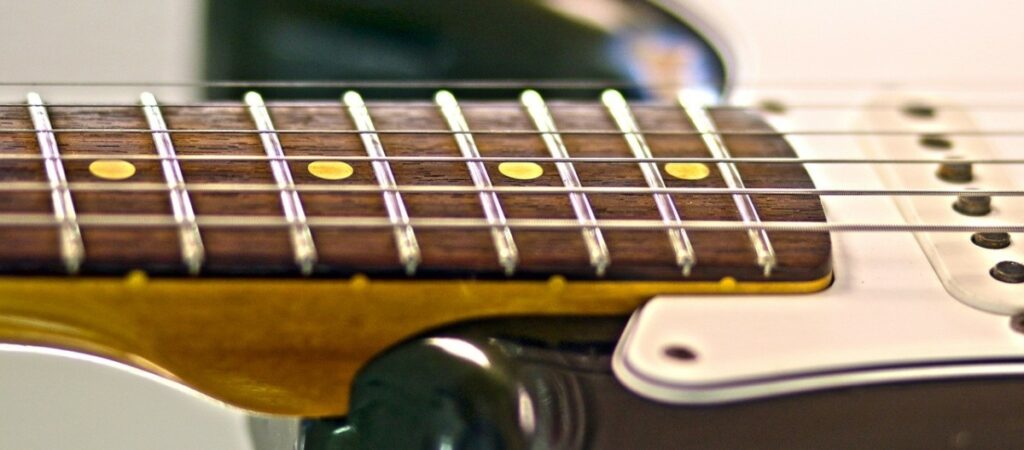Electric and acoustic guitars come from the factory with either a gloss neck, or a satin neck, but which is the best? In this article I’ll compare the feel, aesthetics, and tone of satin and gloss guitar necks to help you decide which is the best choice.
Here’s the quick answer.
Satin guitar neck finishes feel smoother and have less friction compared to gloss neck finishes which feel more grippy and can feel much stickier particularly if the hand is sweaty. The neck finish does not have a noticeable affect on the overall tone of the guitar.

Difference in Feel
One of the main reason why some guitarists prefer the feel of a satin neck compared to a gloss neck, is because it doesn’t feel as sticky. This makes the neck feel faster to play on, which is why satin necks are so popular with shredders and lead guitarists.
Gloss necks on the other hand have more friction, as your hand can get stuck to it more, particularly if you start to sweat. However, some players like the extra grip you get with a gloss neck, it’s all personal preference.
The difference between gloss and satin neck finishes tends to diminish as you keep playing the guitar. After a while, the gloss finish loses some of it’s “stickiness” and becomes a bit smoother.
For some players, the difference between the feel of a satin and gloss neck will be greater than it will for others. It depends on how much your hands sweat, and also how you hold the neck.
If you rest your thumb over the top of the neck, it’s likely that your palm barely touches the neck, in which case, you won’t notice the difference between a gloss and satin neck as much. On the other hand, if you have your thumb resting on the back of the neck, you’ll notice it far more.
I’d highly recommend going to your local guitar store and trying both types of neck finishes out to see which you prefer, as there really is no “best finish”, just preferences.

Difference in Appearance
Satin neck finishes have a slight sheen to them, but look very matte compared to gloss finishes which of course look super shiny. It’s again a personal preference as to which you think looks the best.
Personally, if the neck and body of a guitar are black, I love the look of a gloss finish. However, on guitars with lighter coloured necks, I prefer the look of a satin finish.
One thing to note about gloss necks is that they do show fingerprints very easily, particularly on darker colors, so you may find yourself cleaning the neck more often compared to if it had a satin finish.
Does the Neck Finish Affect the Tone?
There are many factors that affect the tone of an electric guitar, and many debates surrounding them, but what about the neck finish?
Having a gloss or satin finish on the neck of guitar does not have a noticable baring on the tone.
If the neck has no finish whatsoever (bare wood), it may be marginally more resonant, but in a blind test I think it’s highly unlikely most players would notice a difference. Some argue that satin necks sound more resonant, but this isn’t something I have ever been able to detect.
Nitro vs Poly Necks
There are two main types of lacquer that is applied to the neck and body of a guitar:
- Nitrocellulose
- Polyurethane
Both of these types of finish can either be satin or gloss.
Nitrocellulose finishes are predominantly used on high-end guitars as the application process is time consuming and labour intensive. Polyurethane finishes are more durable and cheaper to apply, so have become a lot more popular.
The two types of finishes also feel different from one another.
Nitrocellulose takes a very long time to dry, and never fully dries out in the same way that polyurethane does. As a result, nitro neck finishes always feel a bit stickier. In some cases, a satin nitro neck might actually feel stickier than a gloss poly neck.
Check out this article comparing nitrocellulose and polyurethane finishes to learn more.
Sanding a Gloss Neck into a Satin Neck
If you’re not a fan of your guitar’s gloss neck then you have the option of sanding it to convert the finish from gloss to satin to get that smoother feel, without replacing the neck on your guitar.
Most players opt for 1000-grit sandpaper to remove the bulk of the gloss lacquer and then follow up with 1500-grit sandpaper to make the neck feel as smooth as possible.
Some players opt for the more aggressive sandpaper to start with instead of 1000-grit, as it will remove the gloss finish faster, but this also comes with a greater risk of damaging the neck, so I personally wouldn’t go for anything coarser than 1000-grit.
Here’s the process in action.
The neck will of course get slightly slimmer as you sand it, but you’ll only be removing a small amount of the overall neck so the difference is pretty minimal. You do not need to sand the neck down to bare wood to achieve a satin finish, and I wouldn’t recommend this as it will make the neck more susceptible to humidity changes so it will warp more easily.
Some players absolutely hate the idea of sanding down their guitar’s necks, and if that’s you then you’ll need to either replace the neck entirely, or cope with having a gloss neck finish.
Fender and Squier Guitar Neck Finishes
Satin Neck:
- Fender American Ultra
- Fender American Professional II
- Fender American Performer
- Fender Player/ Player Plus
- Fender Vintera Modified
- Squier Affinity
- Squier Bullet
Gloss Neck:
- Fender American Vintage II
- Fender American Original
- Fender Vintera
- Squier Classic Vibe
Gibson Guitar Neck Finishes
Pretty much every Gibson electric guitar has a gloss finish, whereas most Gibson acoustic guitars have a satin finish.
There are some exceptions though. For example, the Zakk Wylde Les Paul Custom has an unfinished neck which feels very smooth. This is because Zakk likes to sand down the neck on his Les Paul to achieve a more satin feel.
